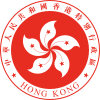Our website is made possible by displaying online advertisements to our visitors.
Please consider supporting us by disabling your ad blocker.
Chief Executive of Hong Kong
| Chief Executive of Hong Kong Special Administrative Region | |
|---|---|
| 香港特別行政區行政長官 | |
 | |
since 1 July 2022 | |
| Government of Hong Kong Office of the Chief Executive | |
| Style |
|
| Type | Head of government |
| Member of | Executive Council |
| Residence | Government House |
| Nominator | Election Committee |
| Appointer | State Council of the People's Republic of China (Decree signed by Premier)[1] |
| Term length | 5 years Re-electable for another maximum 5-year term |
| Constituting instrument | Hong Kong Basic Law |
| Inaugural holder | Tung Chee-hwa |
| Formation | 1 July 1997 |
| Salary | US$675,000[2] |
| Website | ceo.gov.hk/en |
| Chief Executive of Hong Kong | |||||||||||||||||
|---|---|---|---|---|---|---|---|---|---|---|---|---|---|---|---|---|---|
| Traditional Chinese | 香港特別行政區行政長官 | ||||||||||||||||
| Simplified Chinese | 香港特别行政区行政长官 | ||||||||||||||||
| |||||||||||||||||
| Commonly abbreviated as | |||||||||||||||||
| Chinese | 香港特首 | ||||||||||||||||
| |||||||||||||||||
 |
|
Politics and government of Hong Kong |
|
Related topics |
The chief executive of the Hong Kong Special Administrative Region is the representative of the Hong Kong Special Administrative Region and head of the Government of Hong Kong.[3]
The position was created to replace the office of Governor of Hong Kong, the representative of the Monarch of the United Kingdom during British colonial rule.[4] The office, as stipulated by the Hong Kong Basic Law, formally came into being on 1 July 1997 with the handover of Hong Kong from the United Kingdom to the People's Republic of China. The chief executive is head of the executive branch of the Hong Kong government.
The functions of the chief executive include nominating principal officials for appointment by the State Council of China, which is headed by the premier, conducting foreign relations, appointing judges and other public officers, giving consent to legislation passed by the Legislative Council, and bestowing honours. The Basic Law grants the chief executive a wide range of powers, but obliges him or her, before making important policy decisions, introducing bills to the Legislative Council, making subsidiary legislation, and dissolving the Legislative Council, to act only after consultation with the Executive Council (all of whose members are the CE's own appointees).[5] The executive council consists of official and non-official members, including the Chief Secretary for Administration, the most senior official and head of the Government Secretariat, in charge of overseeing the administration of the Government.
The Chief Executive holds the title "The Honourable", and ranks first in the Hong Kong order of precedence.[6] The official residence of the chief executive is Government House in Central, Hong Kong Island.
The current chief executive is John Lee selected as chief executive in the 2022 election, appointed by the Chinese State Council with the designation decree signed by Premier Li Keqiang on 30 May 2022 and took office on 1 July 2022. Lee is the fifth Chief Executive; each of his four predecessors are still living.
- ^ "Government Structure" (PDF). Hong Kong: The Fact. September 2017. Archived from the original (PDF) on 6 October 2017. Retrieved 6 October 2017.
- ^ "11 of the highest-paid world leaders revealed – so who's on top?". South China Morning Post. 29 September 2021.
- ^ Article 43, Hong Kong Basic Law: "The Chief Executive of the Hong Kong Special Administrative Region shall be the head of the Hong Kong Special Administrative Region and shall represent the Region"
- ^ "Bill 1999." Info.gov.hk. Retrieved 28 March 2010.
- ^ Article 56, Hong Kong Basic Law.
- ^ "Precedence list Archived 22 November 2009 at the Wayback Machine." Protocol.gov.hk. Retrieved 28 March 2010.
Previous Page Next Page
رئيس هونغ كونغ التنفيذي Arabic Honkonq prezidentləri AZ Chief Executive of Hong Kong German Κυβερνήτης του Χονγκ Κονγκ Greek Jefe ejecutivo de Hong Kong Spanish Hongkongi tegevjuht ET رئیس اجرایی هنگ کنگ FA Hongkongin hallintojohtaja Finnish Chef de l'exécutif de Hong Kong French ראש הרשות המבצעת של הונג קונג HE



